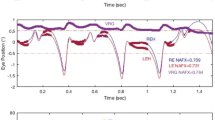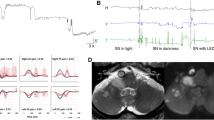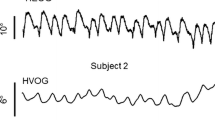Abstract
It has been shown that, during 5 seconds of fixation, an individual with congenital nystagmus (CN) can repeatedly (beat-to-beat) foveate (SD = 12.87 minarc) and maintain low retinal slip velocities (SD = 118.36 minarc/sec). Smooth pursuit data from several CN subjects showed that eye velocities during these foveation intervals approximated target velocity. Despite some claims that CN is caused by absent or “reversed” smooth pursuit, those with CN hardly ever experience oscillopsia or exhibit any accompanying symptoms of such deficits in pursuit; they are able to master sports requiring tracking of rapidly moving small objects (e.g. racquetball or handball). We developed and describe several new methods to accurately assess the function of smooth pursuit in an individual with typical idiopathic CN. We investigated the dynamics of CN foveation periods during smooth pursuit to test the hypothesis that eye velocities would match target velocities during these periods. Unity or near-unity instantaneous (beat-to-beat) pursuit gains of both experimenter-moved and subject-moved targets at peak velocities ranging from only a few deg/sec up to 210°/sec were measured. The dynamic neutral zone was found to shift oppositely to target direction by amounts proportional to the increase in target speed. Our methods proved that eye velocity is made to match target velocity during the foveation intervals and support the conclusion that smooth pursuit in individuals with CN is functioning normally in the presence of the CN oscillation. In addition, we hypothesize that the same fixation mechanism that prevents oscillopsia during fixation of stationary targets, also does so during pursuit.
Similar content being viewed by others
Abbreviations
- CN:
-
Congenital nystagmus
- CS:
-
Catch-up saccade
- DNZ:
-
Dynamic neutral zone
- SNZ:
-
Static neutral zone
- SD:
-
Standard deviation
- Jef:
-
Jerk with extended foveation
- JR(L):
-
Jerk right (left)
- JR(L)ef:
-
Jerk right (left) with extended foveation
- Pfs:
-
Pendular with foveating saccades
- Pfl(r)s:
-
Pendular with left (right) foveating saccades
- PPrfs:
-
Pseudopendular with right foveating saccades
- R(L)PC:
-
Right (left) pseudocycloid
- Gav:
-
Average gain
- Gfp:
-
Gain calculated during the foveation period
- RERfp:
-
Mean retinal error position during foveation period
References
Dell'Osso LF, Fixation characteristics in hereditary congenital nystagmus. Am J Optom Arch Am Acad Optom 1973; 50: 85–90.
Dell'Osso LF, Daroff RB. Congenital nystagmus waveforms and foveation strategy. Doc Ophthalmol 1975; 39: 155–182.
Dell'Osso LF. Evaluation of smooth pursuit in the presence of congenital nystagmus. Neuro-ophthalmol 1986; 6: 383–406.
Kurzan R, Büttner U. Smooth pursuit mechanisms in congenital nystagmus. Neuro-ophthalmol 1989; 9: 313–325.
Collewijn H, Van Der Mark F, Jansen TC. Precise recordings of human eye movements. Vision Res 1975; 15: 447–450.
Steinman RM, Collewijn H. Binocular retinal image motion during active head rotation. Vision Res 1980; 20: 415–429.
Collewijn H, Erkelens CJ, Steinman RM. Binocular co-ordination of human horizontal saccadic eye movements. J Physiol 1988; 404: 157–182.
Collewijn H, Erkelens CJ, Steinman RM. Binocular co-ordination of human vertical saccadic eye movements. J Physiol 1988; 404: 183–197.
Dell'Osso LF, Van der Steen J, Steinman RM, Collewijn H. Foveation dynamics in congenital nystagmus, I: Fixation. Doc Ophthalmol 1992; 79: 1–23.
Hary D, Oshio K, Flanagan SD. The ASYST software for scientific computing. Science 1987; 236: 1128–1132.
Daroff R B, Dell'Osso LF. Periodic alternating nystagmus and the shifting null. Can J Otolaryngol 1974; 3: 367–371.
Abadi RV, Dickinson CM. Waveform characteristics in congenital nystagmus. Doc Ophthalmol 1986; 64: 153–167.
Steinbach MJ. Eye tracking of self-moved objects: The role of efference. J Exp Psychol 1969; 82: 366–376.
Collewijn H, Steinman RM, Van der Steen J. The performance of the smooth pursuit eye movements system during passive and self-generated stimulus motion. J Physiol Lond 1985; 366: 19P.
Yamazaki A. Abnormalities of smooth pursuit and vestibular eye movements in congenital jerk nystagmus. In: Shimaya K, ed. Ophthalmology. Amsterdam: Excerpta Medica, 1979; 1162–1165.
Kommerell G, Mehdorn E. Is an optokinetic defect the cause of congenital and latent nystagmus? In: Lennerstrand G, Zee DS, Keller EL, eds. Functional Basis of Ocular Motility Disorders. Elmsford: Pergamon Press, 1982; 159–167.
Optician LM, Zee DS. A hypothetical explanation of congenital nystagmus. Biol Cyber 1984; 50: 119–134.
Dell'Osso LF. A Dual-Mode Model for the Normal Eye Tracking System and the System with Nystagmus [PhD Dissertation]. University of Wyoming, January 1968.
Dell'Osso LF. A dual-mode model for the normal eye tracking system and the system with nystagmus. IEEE Trans Biomed Engin 1970; BME-17: 87.
Sharpe JA, Sylvester TO. Effects of aging on horizontal smooth pursuit. Invest Ophthalmol Vis Sci 1978; 17: 465–468.
Boman DK, Hotson JR. Smooth pursuit training and disruption. Directional differences and nystagmus. Neuro-ophthalmol 1987; 7: 185–194.
Kowler E, Martins AJ, Pavel M. The effect of expectations on slow oculomotor control-IV. Anticipatory eye movements depend on prior target motions. Vision Res 1984; 24: 197–210.
Kowler, E. The role of visual and cognitive processes in the control of eye movements. In: Kowler E, ed. Eye Movements and Their Role in Visual and Cognitive Processes, Vol. 4. Amsterdam: Elsevier, 1990: 1–70.
Pavel M. Predictive control of eye movements. In: Kowler E, ed. Eye Movements and Their Role in Visual and Cognitive Processes, Vol. 4. Amsterdam: Elsevier, 1990: 71–112.
Meyer CH, Lasker AG, Robinson DA. The upper limit of human smooth pursuit velocity. Vision Res 1985; 25: 561–563.
Van der Steen J. Timing of coordinated head and eye movements during changes in the direction of gaze. In: Berthoz A, Graf W, Vidal PP, eds. The Head-Neck Sensory-Motor System: Evolution, Development, Neuronal Mechanisms, Disorders. New York: Oxford University Press, 1990.
Apkarian P, Spekreijse H, Collewijn H. Oculomotor behavior in human albinos. In: Kolder HEJW, ed. Slow Potentials and Microprocessor Applications. 20th ISCEV Symposium, Iowa City, USA. Documenta Ophthalmologica Proceedings Series, Vol. 37. The Hague: Dr W Junk, 1983: 361–372.
Apkarian P, Spekreijse H. The VEP and misrouted pathways in human albinism. In: Cracco RQ, Bodis-Wollner I, eds. Evoked Potentials. New York: AR Liss, 1986: 211–226.
Halmagyi GM, Gresty MA, Leech J. Reversed optokinetic nystagmus (OKN): mechanism and clinical significance. Ann Neurol 1980; 7: 429–435.
Gresty MA, Page NG, Barratt HJ. The differential diagnosis of congenital nystagmus. J Neurol Neurosurg Psychiat 1984; 47: 936–942.
Abadi RV, Dickinson CM, Lomas MS. Inverted and asymmetrical optokinetic nystagmus. In: Lennerstrand G, Zee DS, Keller EL, eds. Functional Basis of Ocular Motility Disorders. Elmsford: Pergamon Press, 1982: 143–146.
Abadi RV, Dickinson CM. The influence of preexisting oscillations on the binocular optokinetic response. Ann Neurol 1985; 17: 578–586.
Leigh RJ, Dell'Osso LF, Yaniglos SS, Turston SE. Oscillopsia, retinal image stabilization and congenital nystagmus. Invest Ophthalmol Vis Sci 1988; 29: 279–282.
Dell'Osso LF, Leigh RJ. Oscillopsia and retinal image stabilization in congenital nystagmus. Invest Ophthalmol Vis Sci (ARVO Suppl) 1987; 28: 34.
Dell'Osso LF, Leigh RJ. Foveation periods and oscillopsia in congenital nystagmus. Invest Ophthalmol Vis Sci (ARVO Suppl) 1990; 31: 122.
Abel LA, Williams IW, Levi L. Oscillopsia suppression in congenital nystagmus: dependence on foveation stability and duration. Invest Ophthalmol Vis Sci (ARVO Suppl) 1990; 31: 122.
Author information
Authors and Affiliations
Rights and permissions
About this article
Cite this article
Dell'osso, L.F., Van Der Steen, J., Steinman, R.M. et al. Foveation dynamics in congenital nystagmus II: Smooth pursuit. Doc Ophthalmol 79, 25–49 (1992). https://doi.org/10.1007/BF00160131
Accepted:
Issue Date:
DOI: https://doi.org/10.1007/BF00160131




